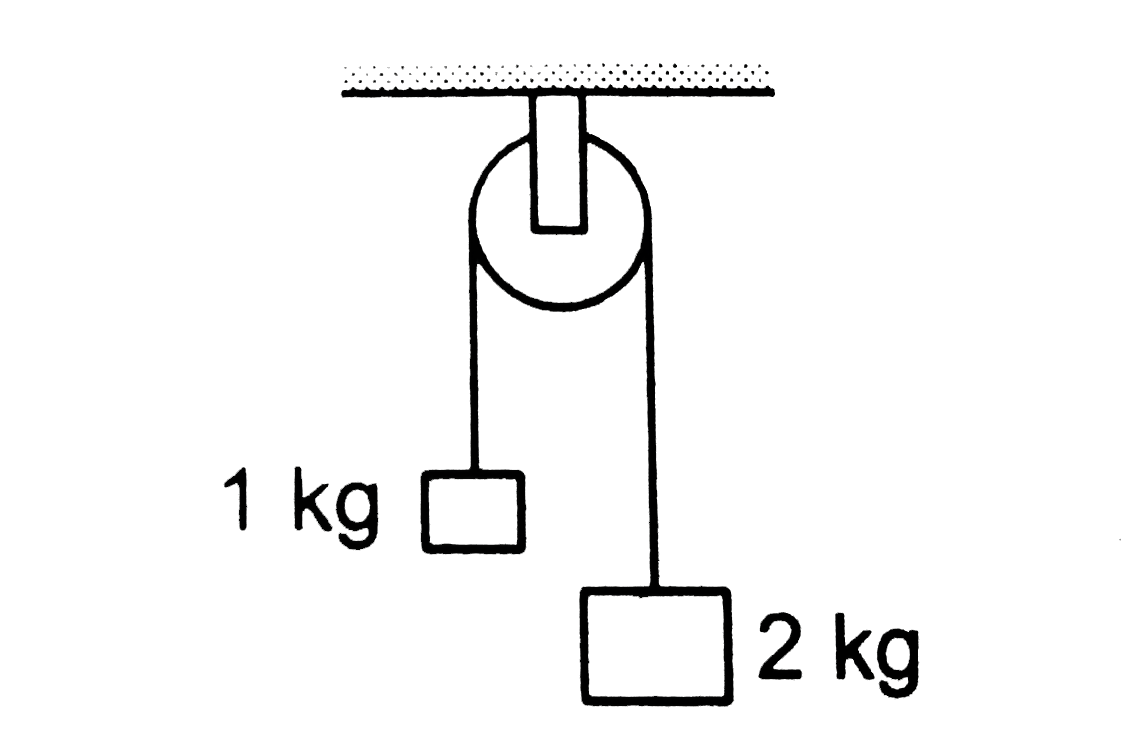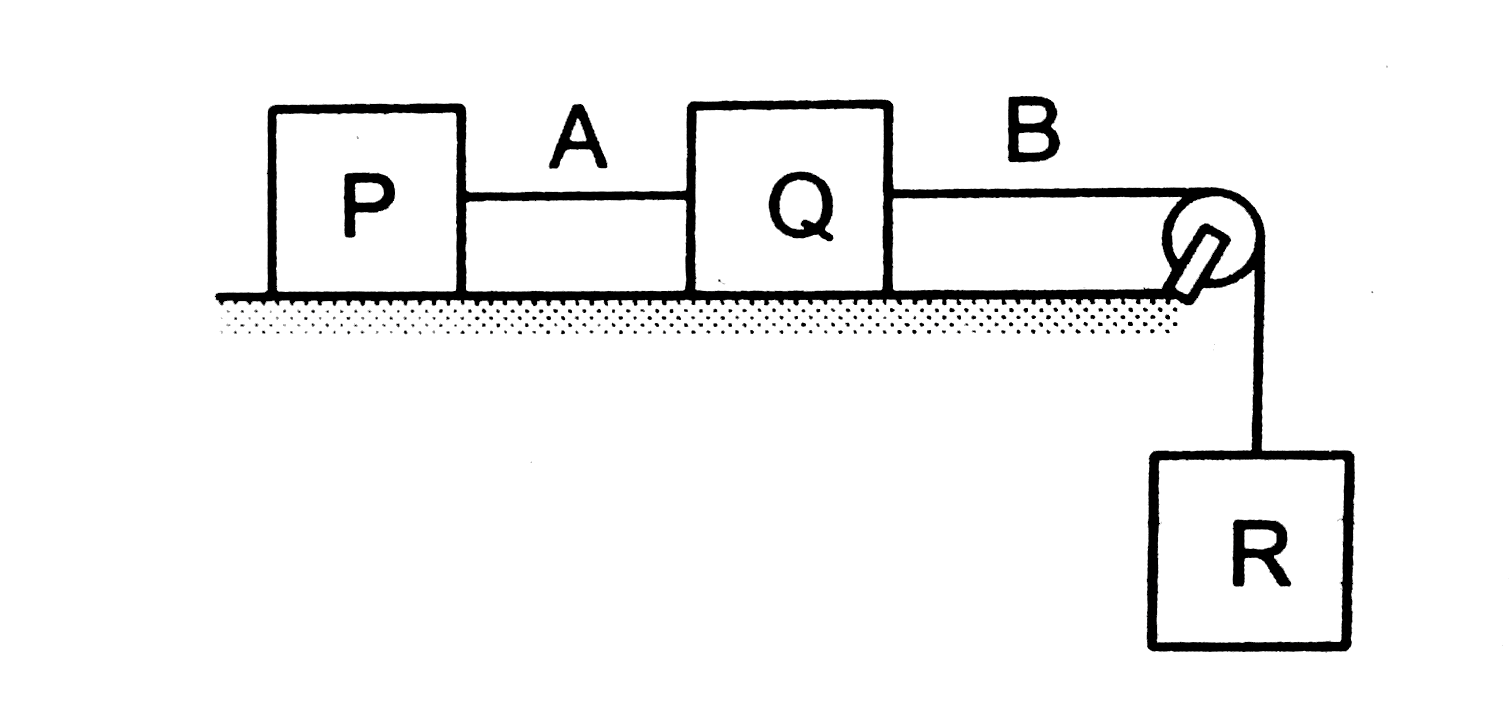Complete Solutions to Worked out Example of chapter SOME MECHANICAL PROPERTIES OF MATTER of Class 11 book with complete answers and questions
| Class 11 | PHYSICS |
| Chapter | SOME MECHANICAL PROPERTIES OF MATTER |
| HC VERMA | Worked out Example |
| Number Of Questions | 17 |
| Academic Year | 2023-24 |
One end of a wire 2m long and 0.2 cm^2 in cross section is fixed in a ceiling and a load of 4.8 kg is attached to the free end. Find the extension of the wire. Young modulus of steel `=2.0xx10^11Nm^-2`. Take `g=10ms^-2`.
View SolutionOne end of a nylon rope of length 4.5 m and diameter 6 mm is fixed to a tree limb. A monkey weighing 100 N jumps to catch the free end and stays there. Find the elongation of the rope and the corresponding change in the diameter. Young modulus of nylon =`4.8xx10^11Nm^(-2)` and poisson ratio of nylon =`0.2`.
View SolutionTwo blocks of masses 1 kg and 2kg are connect by a metal wire going over a smooth pulley as shown in figure. The breaking stress of the metal is `2xx10^9Nm^-2`. What should be the minimum radius of the wire used if it is not to break? Take `g=10ms^-2`

View SolutionTwo wires of equal cross section but one made of steel and the other of copper, are joined end to end. When the combination is kept under tension, the elongations in the two wires are found to be equal. Find the ratio of the lengths of the two wires. Young modulus of steel `=2.0xx10^11Nm^-2` and that of copper `=1.1xx10^11Nm^-2`
View SolutionFind the decrease in the volume of a sample of water from the following data. Initial volume `=1000 cm^3` initial pressure `=10^5Nm^-2, ` final pressure `=10^6Nm^-2`, compressibility of water `=50xx10^-11m^2N^-1`.
View SolutionOne end of a metal wire is fixed to a ceiling and a load of 2 kg hangs from the other end. A similar wire is attached to the bottom of the load and another load of 1 kg hangs from this lower wire. Find the longitudinal strain in both wires. Area of cross section of each wire is `0.005 cm^2` and Young modulus of the metal is `2.0xx10^11 Nm^-2.` Take `g=10ms^-2`
View SolutionEach of the three blocks P, Q and R shown in figure has a mass of 3 kg. Each of the wires A and B has cross sectional area `0.005 cm^2` and Young modulus `2xx10^11Nm^-2`. Neglect friction. Find the longitudinal strain developed in each of the wires. Take `g=10ms^-2`

View SolutionA wire of area of cross section `3.0mm^2` and natural length 50 cm is fixed at one end and a mas of 2.1 kg is hung from the other end. Find the elastic potential energy stored in the wire in steady state. Young modulus of the material of the wire `=1.9xx10^11Nm^-2. Take g=10ms^-2`
View SolutionA block of weight 10 N is fastened to one end of a wire of cross sectional area `3 mm^2` and is rotated in a vertical circle of radius 20 cm. The speed of the block at the bottom of the circle is `2ms^-1`. Find the elongation of the wire when the block is at the bottom of the circle. Young modulus of the material of the wire `=2xx10^11Nm^-2`.
View SolutionA uniform heavy rod of weight W, cross sectional area a and length L is hanging from fixed support. Young modulus of the material of the rod is Y. Neglect the lateral contraction. Find the elongation of the rod.
View SolutionThere is an air bubble of radius 1.0 mm in a liquid of surface tension `0.075Nm^-1` and density `1000 kg m^-3`. The bubble is at a depth of 10 cm below the free surface. By what amount is the pressure inside the bubble greater than the atmospheric pressure? Take `g=9.8ms^-2`.
View SolutionA light wire AB of length 10 cm can slide on a vertical frame as shown in figure. There is a film of soap solution trapped between the frame and the wire. Find the load W that should be suspended from the wire to keep it in equilibrium. Neglect friction. Surface tension of soat solution `=25` dyne `cm^-1`. Take `g=10 ms^-2`

View SolutionThe lower end of a capillary tube is dipped into water and it is seen that the water rises through 7.5 cm in the capillary. Find the radius of the capilary. Surface tension of water `=7.5xx10^-2Nm^-1`. Contact angle between water and glass `=0^@. Take g=10ms^-2`.
View SolutionTwo mercury drops each of radius r merge to form a bigger drop. Calculate the surface energy released.
View SolutionA large wooden plate of area `10m^2` floating on the surface of river is made to move horizontally with a speed of `2ms^-1` by applying a tangential force. If the river is 1m deep and the water in contact with the bed is stationary, find the tangential force needed to keep the plate moving. Coefficient of viscosity of water at the temperature of the river `=10^-2 poise.`
View SolutionThe velocity of water in a river is `18kmh^-1` near the surface. If the river is 5 m deep, find the shearing stress between the horizontal layers of water. The coefficient of viscosity of water `=10^-2 poise.`
View SolutionFind the terminal velocity of a rain drop of radius 0.01 mm. The coefficient of viscosity of air is `1.8xx10^-5 N-sm^-2` and its density is `1.2kgm^-3`.Density of water `=1000kgm^-3`. ` Take g=10ms^-2`
View Solution
Worked out Example questions and complete solutions for chapter SOME MECHANICAL PROPERTIES OF MATTER of HC VERMA PHYSICS (ENGLISH) of Class 11